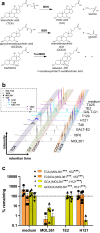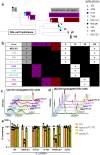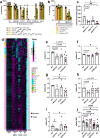Gut microbiota Turicibacter strains differentially modify bile acids and host lipids
- PMID: 37339963
- PMCID: PMC10281990
- DOI: 10.1038/s41467-023-39403-7
Gut microbiota Turicibacter strains differentially modify bile acids and host lipids
Abstract
Bacteria from the Turicibacter genus are prominent members of the mammalian gut microbiota and correlate with alterations in dietary fat and body weight, but the specific connections between these symbionts and host physiology are poorly understood. To address this knowledge gap, we characterize a diverse set of mouse- and human-derived Turicibacter isolates, and find they group into clades that differ in their transformations of specific bile acids. We identify Turicibacter bile salt hydrolases that confer strain-specific differences in bile deconjugation. Using male and female gnotobiotic mice, we find colonization with individual Turicibacter strains leads to changes in host bile acid profiles, generally aligning with those produced in vitro. Further, colonizing mice with another bacterium exogenously expressing bile-modifying genes from Turicibacter strains decreases serum cholesterol, triglycerides, and adipose tissue mass. This identifies genes that enable Turicibacter strains to modify host bile acids and lipid metabolism, and positions Turicibacter bacteria as modulators of host fat biology.
© 2023. The Author(s).
Conflict of interest statement
Findings regarding the host effects of
Figures






Similar articles
-
The gut bacterium Extibacter muris produces secondary bile acids and influences liver physiology in gnotobiotic mice.Gut Microbes. 2021 Jan-Dec;13(1):1-21. doi: 10.1080/19490976.2020.1854008. Gut Microbes. 2021. PMID: 33382950 Free PMC article.
-
Genetic determinants of gut microbiota composition and bile acid profiles in mice.PLoS Genet. 2019 Aug 29;15(8):e1008073. doi: 10.1371/journal.pgen.1008073. eCollection 2019 Aug. PLoS Genet. 2019. PMID: 31465442 Free PMC article.
-
Unconjugated and secondary bile acid profiles in response to higher-fat, lower-carbohydrate diet and associated with related gut microbiota: A 6-month randomized controlled-feeding trial.Clin Nutr. 2020 Feb;39(2):395-404. doi: 10.1016/j.clnu.2019.02.037. Epub 2019 Feb 27. Clin Nutr. 2020. PMID: 30876827 Clinical Trial.
-
Diversification of host bile acids by members of the gut microbiota.Gut Microbes. 2020;11(2):158-171. doi: 10.1080/19490976.2019.1674124. Epub 2019 Oct 9. Gut Microbes. 2020. PMID: 31595814 Free PMC article. Review.
-
Interactions between gut bacteria and bile in health and disease.Mol Aspects Med. 2017 Aug;56:54-65. doi: 10.1016/j.mam.2017.06.002. Epub 2017 Jun 21. Mol Aspects Med. 2017. PMID: 28602676 Review.
Cited by
-
Gut Microbial Adaptation to Varied Altitudes and Temperatures in Tibetan Plateau Yaks.Microorganisms. 2024 Jul 1;12(7):1350. doi: 10.3390/microorganisms12071350. Microorganisms. 2024. PMID: 39065118 Free PMC article.
-
Exposure and resistance to lantibiotics impact microbiota composition and function.bioRxiv [Preprint]. 2023 Dec 30:2023.12.30.573728. doi: 10.1101/2023.12.30.573728. bioRxiv. 2023. PMID: 38234830 Free PMC article. Preprint.
-
Species-level characterization of the core microbiome in healthy dogs using full-length 16S rRNA gene sequencing.Front Vet Sci. 2024 Sep 2;11:1405470. doi: 10.3389/fvets.2024.1405470. eCollection 2024. Front Vet Sci. 2024. PMID: 39286595 Free PMC article.
-
Causal relationship between the gut microbiome and basal cell carcinoma, melanoma skin cancer, ease of skin tanning: evidence from three two-sample mendelian randomisation studies.Front Immunol. 2024 Jan 18;15:1279680. doi: 10.3389/fimmu.2024.1279680. eCollection 2024. Front Immunol. 2024. PMID: 38304424 Free PMC article.
-
Ecological Stability Emerges at the Level of Strains in the Human Gut Microbiome.mBio. 2023 Apr 25;14(2):e0250222. doi: 10.1128/mbio.02502-22. Epub 2023 Feb 21. mBio. 2023. PMID: 36809109 Free PMC article.
References
-
- Rabot S, et al. Germ-free C57BL/6J mice are resistant to high-fat-diet-induced insulin resistance and have altered cholesterol metabolism. FASEB J. 2010;24:4948–4959. - PubMed
Publication types
MeSH terms
Substances
LinkOut - more resources
Full Text Sources
Molecular Biology Databases
Miscellaneous

